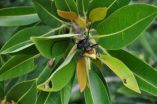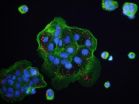(Press-News.org) For the tiny Daubenton's bat, the attractions of family life seem to vary more with altitude than with the allure of the opposite sex.
For more than a decade, a team led by Professor John Altringham from the University of Leeds' School of Biology has studied a population of several hundred bats along a 50-km stretch of the River Wharfe. They monitored roosts in Ilkley and Addingham, upstream in the market town of Grassington and higher still in the villages of Kettlewell and Buckden.
The researchers found that all Daubenton's bats in nursery roosts in lowland areas of Wharfedale during the spring and summer were females and their offspring.
Male bats were mostly restricted to a windier, Heathcliff-like existence in roosts at the top of the Dales.
But the researchers were surprised to find a small oasis of cohabitation in Grassington, sandwiched between the bustle of the women-only childrearing in the lowlands and the more relaxed lives of the bachelors in the highlands.
Professor Altringham said: "Low down the dale, the females appear not to tolerate males and we assume they won't let them in the roost. They don't want anything to do with them. High in the dales, all the roosts are bachelor pads. But in the middle, at Grassington, males and females live together—the social structure changes with the environment"
"One possible reason for not finding males low down the valley could be that the mothers just want to avoid competing with males for food. It takes a lot of insects to make the milk needed to feed their young," Professor Altringham said.
"But it is also possible that the males choose not to roost with the females. When you look at the nursery colony in Ilkley, mothers and pups often have a lot of ectoparasites like ticks and mites. In a warm, crowded nursery, parasites can thrive, especially if there's less time for good personal hygiene. Parasites not only make life uncomfortable but can affect a bat's health. The males that live by themselves are usually very clean in their bachelor pads, so you can understand why they might not want to move in," he added.
At Grassington, which is deep in the Yorkshire Dales National Park but not as high as Buckden and Kettlewell, the bats have a completely different social structure. Both male and female bats live with the young throughout the spring and summer in roosts in the stonework of the old Dales bridges and in holes in ash trees.
"Females may roost as high up the dale as Grassington because they have these warm, cuddly males to bunk up with. This way, females use less energy keeping warm and babies grow faster," Professor Altringham said. "In these marginal conditions, they may just tolerate a few males to keep them warm. Otherwise they kick them out. Why do the males co-habit if they are going to get parasites all over them? Well, that may be down to the usual answer: sex."
Although male and female Daubenton's bats usually live apart throughout the spring and summer, they meet when they begin flying to caves in late summer.
Professor Altringham said: "In and around these caves the bats gather in huge numbers to mate, in a behaviour known as swarming. This is clubbing for bats, with males displaying to females in lengthy acrobatic chases. As winter closes in, these caves will ultimately be their hibernation sites.
"There are nearly 2,000 cave entrances and hundreds of kilometres of cave passages in the Dales and these attract bats from all over Yorkshire, Lancashire, Cumbria and beyond for mating and hibernation. The males in Grassington may be giving themselves the opportunity to mate with the females late in the summer before they even get to the caves."
The researchers have built up a detailed picture of social and sexual behaviour by genotyping hundreds of individuals. The evidence gathered from this supports the theory that the Grassington males enjoy an advantage in mating.
"At Grassington, most of the fathers of bats born there spent the summer with the females. If we look at pups in Addingham and Ilkley, their dads were males caught when swarming at caves. So, as well as two different mating systems, you have distinct social groupings. A bachelor from Buckden is always a bachelor from Buckden. He doesn't pop down to Grassington to visit the females in the summer. His only option seems to be to go clubbing in the autumn," Professor Altringham said.
The Daubenton's bat, named after the 18th Century French naturalist Louis-Jean-Marie Daubenton, is widespread across the United Kingdom and specialises in hunting insects over water. Full-grown adults weigh only 7 to 12 grams, but they can live for 20 years or more.
"These bats are the size of a shrew but have a very different lifecycle. A shrew typically spends its entire life in a few metres of hedgerow, eats and breeds with a ferocious intensity, for a year if it is lucky, and then dies. In contrast, these bats lead a complex life over a huge area and females produce only one pup a year," Professor Altringham said. "This makes bats particularly vulnerable to the problems of habitat fragmentation and climate change."
###
The paper, which is published in PLOS ONE, was co-authored by Dr Ruth Angell and Professor John Altringham at The University of Leeds and by Professor Roger Butlin at Sheffield University. It was funded by a Natural Environment Research Council (NERC) PhD studentship to Ruth Angell, with additional support from the NERC Biomolecular Analysis Facility at Sheffield.
Further information:
Professor John Altringham is available for interview. Images and a map are available on request.
A copy of the full paper—Ruth L. Angell, Roger K. Butlin and John D. Altringham. 'Sexual segregation and flexible mating patterns in temperate bats,' PLOS ONE (DOI 10.1371/journal.pone.0054194) is also available on request.
Contact:
Chris Bunting
Press Officer
University of Leeds
The paper will be available for download from 10 pm London Time / 5 pm US Eastern Time on Thursday 24 January 2013.
Concerns that many animals are becoming extinct, before scientists even have time to identify them, are greatly overstated according Griffith University researcher, Professor Nigel Stork.
Professor Stork has taken part in an international study, the findings of which have been detailed in "Can we name Earth's species before they go extinct?" published in the journal Science.
Deputy Head of the Griffith School of Environment, Professor Stork said a number of misconceptions have fuelled these fears, and there is no evidence that extinction rates are as high as some have ...
The diversity of biobanks, collections of human specimens from a variety of sources, raises questions about the best way to manage and govern them, finds a study published in BioMed Central's open access journal Genome Medicine. The research highlights difficulties in standardizing these collections and how to make these samples available for research.
Biobanks have been around for decades, storing hundreds of millions of human specimens. But there has been a dramatic increase in the number of biobanks in the last ten years, since the human genome sequencing project. ...
CHAPEL HILL, N.C. – Cells in the immune system called macrophages normally engulf and kill intruding bacteria, holding them inside a membrane-bound bag called a vacuole, where they kill and digest them.
Some bacteria thwart this effort by ripping the bag open and then escaping into the macrophage's nutrient-rich cytosol compartment, where they divide and could eventually go on to invade other cells.
But research from the University of North Carolina School of Medicine shows that macrophages have a suicide alarm system, a signaling pathway to detect this escape into ...
Out-of-pocket costs resulting from breast cancer care in the year following diagnosis are likely manageable for most women, but some women are at a higher risk of experiencing the financial burden that comes from those costs in Canadian breast cancer patients, according to a study published January 24 in the Journal of the National Cancer Institute.
While extensive information about the level of out-of-pocket costs after early breast cancer diagnosis has been unavailable until now, the costs resulting from the disease and the effects the costs have on family financial ...
There is no association between total fruit and vegetable intake and risk of overall breast cancer, but vegetable consumption is associated with a lower risk of estrogen receptor-negative (ER-) breast cancer, according to a study published January 24 in the Journal of the National Cancer Institute.
The intake of fruits and vegetables has been hypothesized to lower breast cancer risk, however the existing evidence is inconclusive. There are many subtypes of breast cancer including ER- and ER positive (ER+) tumors and each may have distinct etiologies. Since ER- tumors, ...
The authors say spotting it early could substantially reduce the risk, and this needs to become a cornerstone of safety and effectiveness in antenatal care.
Stillbirth rates in the United Kingdom are among the highest in developed countries. They have often been considered unexplained and unavoidable, and their rates have changed little over the last two decades.
Recently, doctors have found that many stillborn babies fail to reach their growth potential, prompting a renewed focus on what causes fetal growth restriction. So a team of researchers at the West Midlands ...
New research reveals a potential way for how parents' experiences could be passed to their offspring's genes. The research was published today, 25 January, in the journal Science.
Epigenetics is a system that turns our genes on and off. The process works by chemical tags, known as epigenetic marks, attaching to DNA and telling a cell to either use or ignore a particular gene.
The most common epigenetic mark is a methyl group. When these groups fasten to DNA through a process called methylation they block the attachment of proteins which normally turn the genes on. ...
BOSTON—Two new mutations that collectively occur in 71 percent of malignant melanoma tumors have been discovered in what scientists call the "dark matter" of the cancer genome, where cancer-related mutations haven't been previously found.
Reporting their findings in the Jan. 24 issue of Science Express, the researchers from Dana-Farber Cancer Institute and the Broad Institute said the highly "recurrent" mutations – occurring in the tumors of many people – may be the most common mutations in melanoma cells found to date.
The researchers said these cancer-associated ...
(Edmonton) A University of Alberta professor has revealed the workings of a celestial event involving binary stars that results in an explosion so powerful it ranks close to Supernovae in luminosity.
Astrophysicists have long debated about what happens when binary stars, two stars that orbit one another, come together in a common envelope.
When this dramatic cannibalizing event ends there are two possible outcomes; the two stars merge into a single star or an initial binary transforms in an exotic short-period one.
The event is believed to take anywhere from a dozen ...
(MEMPHIS, Tenn. – January 24, 2013) Genome sequencing data once regarded as junk is now being used to gain important clues to help understand disease. The latest example comes from the St. Jude Children's Research Hospital – Washington University Pediatric Cancer Genome Project, where scientists have developed an approach to mine the repetitive segments of DNA at the ends of chromosomes for insights into cancer.
These segments, known as telomeres, had previously been ignored in next-generation sequencing efforts. That is because their repetitive nature meant that the ...


